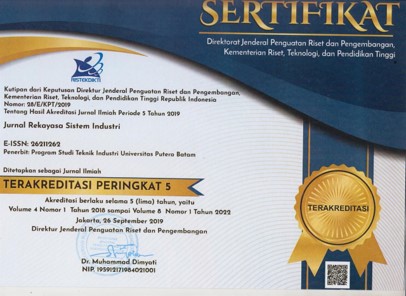PENERAPAN LEAN MANUFACTURING DALAM PENINGKATAN PRODUKTIVITAS ALUMUNIUM BAKING TRAY
DOI:
https://doi.org/10.33884/jrsi.v7i1.4543Keywords:
Waste, FMEA, Craig-Harris Methode, Lean manufacturingAbstract
Along with the rapid growth of the manufacturing industry, companies are required to create advantages in order to survive and compete with competing companies. Competition between companies requires every manufacturer to make improvements for the better. One of the industry players who are expected to make improvements is TS. aluminum. Where the improvements made focus on the production process line related to the company's productivity. The production process often arises in the form of a series of wastes such as waiting time (waiting time), work in process (WIP) and transportation that is too long. A number of these wastes can result in disruption to performance and decreased productivity. Through this research, efforts were made to reduce waste by using lean manufacturing, VSM, and FMEA. The results showed that there was a decrease in the set up time to 2135 seconds, the waiting time between cutting and filing operations to 256.8 seconds, the turning waiting time to 262.31 and the loss of transportation distance by 22 m in the finishing polishing operation which resulted in the time required reduced to 123.94 seconds. In addition, the company experienced an increase in labor productivity of 5.18, capital productivity of 28.52, productivity of raw materials 4.3, productivity of other components by 33.65 and total productivity of the company by 2.04.
References
Alefari, M., Almanei, M., & Salonitis, K. (2020). Lean manufacturing, leadership and employees: the case of UAE SME manufacturing companies. Production and Manufacturing Research, 8(1), 222–243. https://doi.org/10.1080/21693277.2020.1781704
Ananthukrishna, A. (2019). The effectiveness of implementing lean manufacturing techniques. International Journal of Management, 10(2), 47–51. https://doi.org/10.34218/IJM.10.2.2019/005
Ardianto, R., & Jakaria, R. B. (2021). American Productivity Center (APC) and Craig-Harris Productivity Model method in measuring the productivity of customs companies. Procedia of Engineering and Life Science, 1(1). https://doi.org/10.21070/pels.v1i1.647
Balaraju, J., Govinda Raj, M., & Murthy, C. S. (2019). Fuzzy-FMEA risk evaluation approach for LHD machine-A case study. Journal of Sustainable Mining, 18(4), 257–268. https://doi.org/10.1016/j.jsm.2019.08.002
Buer, S. V., Semini, M., Strandhagen, J. O., & Sgarbossa, F. (2021). The complementary effect of lean manufacturing and digitalisation on operational performance. International Journal of Production Research, 59(7), 1976–1992. https://doi.org/10.1080/00207543.2020.1790684
Dedimas, T., & Gebeyehu, S. G. (2019). Application of failure mode effect analysis (FMEA) for efficient and cost-effective manufacturing: A case study at Bahir Dar textile share company, Ethiopia. Journal of Optimization in Industrial Engineering, 12(1), 23–29. https://doi.org/10.22094/joie.2018.556677.1533
Doshi, J., & Desai, D. (2017). Application of failure mode & effect analysis (FMEA) for continuous quality improvement - multiple case studies in automobile SMEs. International Journal for Quality Research, 11(2), 345–360. https://doi.org/10.18421/IJQR11.02-07
Henao, R., Sarache, W., & Gómez, I. (2019). Lean manufacturing and sustainable performance: Trends and future challenges. In Journal of Cleaner Production (Vol. 208, pp. 99–116). https://doi.org/10.1016/j.jclepro.2018.10.116
Herrera, M. K. I. F., Portillo, M. T. E., López, R. R., & Gómez, J. A. H. (2019). Lean manufacturing tools that influence an organization’s productivity: Conceptual model proposed. Revista Lasallista de Investigacion, 16(1), 115–133. https://doi.org/10.22507/rli.v16n1a6
Jain, K. (2017). Use of failure mode effect analysis (FMEA) to improve medication management process. International Journal of Health Care Quality Assurance, 30(2), 175–186. https://doi.org/10.1108/IJHCQA-09-2015-0113
Jamil, N., Gholami, H., Saman, M. Z. M., Streimikiene, D., Sharif, S., & Zakuan, N. (2020). DMAIC-based approach to sustainable value stream mapping: towards a sustainable manufacturing system. Economic Research-Ekonomska Istrazivanja , 33(1), 331–360. https://doi.org/10.1080/1331677X.2020.1715236
Kale, S. V., & Parikh, R. H. (2019). Lean implementation in a manufacturing industry through value stream mapping. International Journal of Engineering and Advanced Technology, 8(6 Special issue), 908–913. https://doi.org/10.35940/ijeat.F1172.0886S19
Kementrian KUKM. (2021). Perkembangan Data Usaha Mikro, Kecil, Menengah, dan Usaha Besar. Www.Depkop.Go.Id, 2000(1), 1.
Meudt, T., Metternich, J., & Abele, E. (2017). Value stream mapping 4.0: Holistic examination of value stream and information logistics in production. CIRP Annals - Manufacturing Technology. https://doi.org/10.1016/j.cirp.2017.04.005
Novia, M. A., Semmaila, B., & Imaduddin, I. (2020). Pengaruh kualitas Layanan Dan Kualitas Produk Terhadap Kepuasan Pelanggan. Tata Kelola, 7(2), 201–212. https://doi.org/10.52103/tatakelola.v7i2.174
Publikasi BPS. (2020). Publikasi Statistik Indonesia 2020. PUBLIKASI STATISTIK INDONESIA 2020, April, 192.
Sudhakara, P. R., Sałek, R., Venkat, D., & Chruzik, K. (2020). Management of non-value-added activities to minimize lead time using value stream mapping in the steel industry. Acta Montanistica Slovaca, 25(3), 444–445. https://doi.org/10.46544/AMS.v25i3.15
Taher-Ghahremani, F., & Omidvari, M. (2018). Providing an evaluation model of Green Productivity in paper-making industries. International Journal of Environmental Science and Technology, 15(2), 333–340. https://doi.org/10.1007/s13762-017-1370-7
Wicaksono, I., & Karningsih, P. D. (2017). Evaluasi Performansi Dan Strategi Perbaikan Pada Lini Produksi Press Forming Di Pt Dirgantara Indonesia Dengan Menggunakan Lean Assessment Dan Lean Manufacturing. Jurnal Teknik ITS, 6(2). https://doi.org/10.12962/j23373539.v6i2.25444
Downloads
Published
Issue
Section
License

This work is licensed under a Creative Commons Attribution-NonCommercial-ShareAlike 4.0 International License.
















